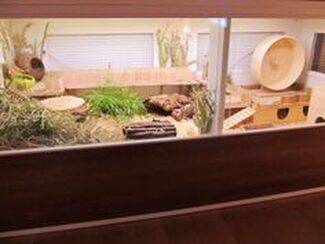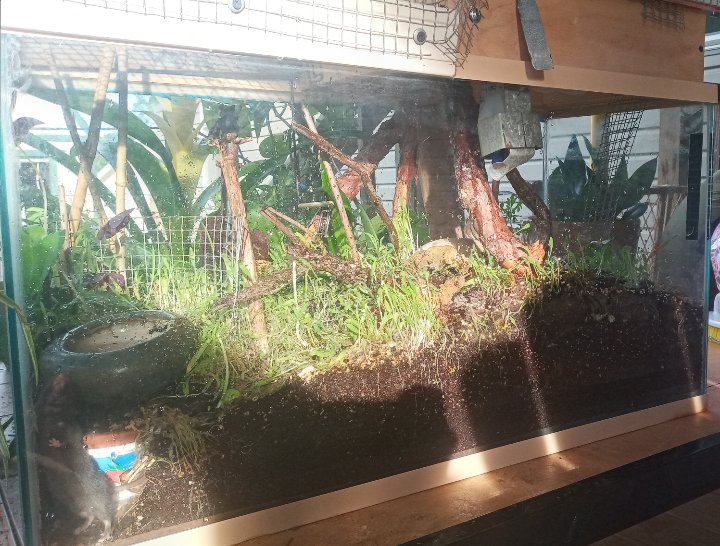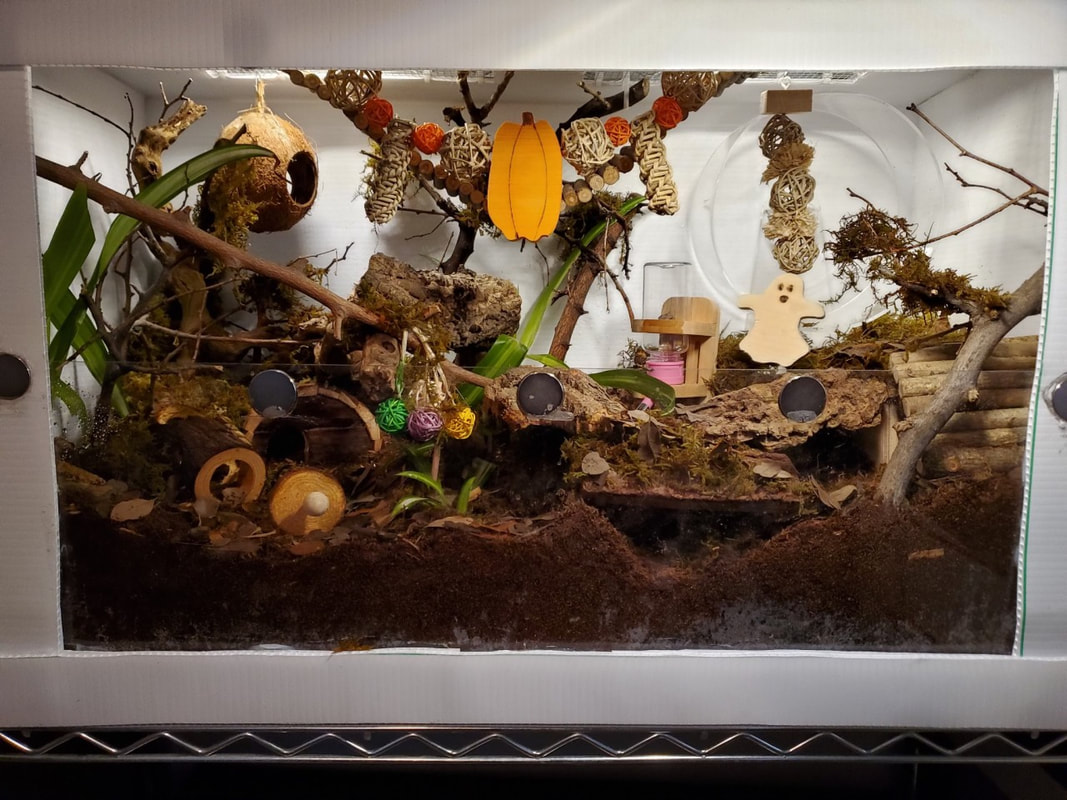General Information:
Asian dormouse is a genre of several species of Asiatic dormice. Despite there being several species spread throughout various localities, we're discussing the Asiatic Garden dormice (AGD). Although they're common throughout Asia, they're very uncommon in the pet trade.
AGD are longlived mice with an average lifespan of around 5-6 years. They're also surprisingly vocal mice and, like most dormice, have furry tails.
They're an omnivorous and nocturnal rodent belonging to the family Gliridae.
Care:
Housing/Enrichment:
AGDs require a large tank or vivarium approximately 4-5ft. They forage both on the ground and up in trees so they must have plenty of floor space and items to climb. Consider enrichment such as branches, ropes, wooden bridges, hides, and similar items.
A considerable amount of safe substrate to forage through and a nesting material such as hay and straw will help mimic a natural environment. AGDs are found throughout shrubland, woodlands, mountainsides, and other rocky areas.
Asian Garden Dormice will go into torpor if the temperature of their environment isn't monitored.
Useful Links:
Asian dormouse is a genre of several species of Asiatic dormice. Despite there being several species spread throughout various localities, we're discussing the Asiatic Garden dormice (AGD). Although they're common throughout Asia, they're very uncommon in the pet trade.
AGD are longlived mice with an average lifespan of around 5-6 years. They're also surprisingly vocal mice and, like most dormice, have furry tails.
They're an omnivorous and nocturnal rodent belonging to the family Gliridae.
Care:
Housing/Enrichment:
AGDs require a large tank or vivarium approximately 4-5ft. They forage both on the ground and up in trees so they must have plenty of floor space and items to climb. Consider enrichment such as branches, ropes, wooden bridges, hides, and similar items.
A considerable amount of safe substrate to forage through and a nesting material such as hay and straw will help mimic a natural environment. AGDs are found throughout shrubland, woodlands, mountainsides, and other rocky areas.
Asian Garden Dormice will go into torpor if the temperature of their environment isn't monitored.
Useful Links:
- www.ebay.co.uk/itm/303636876250?mkevt=1&mkcid=1&mkrid=710-53481-19255-0&campid=5338358731&toolid=10029&customid=Cj0KCQjw8vqGBhC_ARIsADMSd1Dh133MKNL5bYrurTMfDJ7F8HN7EyNVpOWXrvbIHvw5mMcwf49dUL0aAl7vEALw_wcB
- provivs.co.uk/180cm-x-90cm-x-60cm--72x36x24-flat-packed-vivarium-6ft-223-p.asp?_=&variantid=225&gclid=Cj0KCQjw8vqGBhC_ARIsADMSd1CzkCJmWCEdE3FdXhIYBF9clJCB8WARzC6UFrSQp14yqeurcpg17qsaAld1EALw_wc
- www.reptilecentre.com/lucky-reptile-premium-grapevine-large_p31143199.htm?gclid=Cj0KCQjw8vqGBhC_ARIsADMSd1BKFu7FjxzcSrOmy4B3n59mN7rTQFwHB7l5TAfgINIw4iM3pL_TQRcaAvaFEALw_wcB
- www.internetreptile.com/internet-reptile-cork-bark-medium-tube-short/?utm_medium=cpc&gclid=Cj0KCQjw8vqGBhC_ARIsADMSd1CUQY-U4O8wI1vtc3msmNMYSswaYI4ZFUTGw8sLQ1cVaj31RPFZC0YaAlWIEALw_wcB#fo_c=2683&fo_k=e0272b0be2ebe6c1f916bbc0c2aa355a&fo_s=gplauk
- www.burnhills.com/equestrian-c3/for-the-stable-c12/stable-supplies-c212/bedding-c213/ecoshiv-hemp-shiv-hemp-horse-bedding-aprox-20kg-p4737/s17407?cid=GBP&gclid=Cj0KCQjw8vqGBhC_ARIsADMSd1BuEJvv955GSaBexDAxBfstKIaGSw3sbx6tSO01RiYRRv-EfQ5GLfwaAlt3EALw_wcB
Socialising:
AGDs are rarely friendly and are certainly not easy to handle. They will let you know how they're feeling by growling and barking at you. You must pay attention to their behaviour and vocalisations. AGDs have a painful bite and will bite if they feel threatened.
For that reason, we would consider them a look-but-don't-touch pet.
Most dormice live in small family groups.
Diet:
A varied omnivorous diet is essential for your AGDs wellbeing. Their natural diet consists of mostly snails, insects, centipedes and geckos. They do also consume plant matter. Interestingly, dormice lack a cecum (a pouch attached to the junction of the small intestines), meaning they cannot digest cellulose. For this reason, it's advised you do not feed dormice vegetables.
We recommend feeding both a varied bird seed mix, an insectivore mix, nectar (acacia honey and red nectar), and some fruits. You can also feed live insects such as crickets, locusts, mealworms, as well as scrambled egg.
Useful Links:
Please feel free to ask more questions.
AGDs are rarely friendly and are certainly not easy to handle. They will let you know how they're feeling by growling and barking at you. You must pay attention to their behaviour and vocalisations. AGDs have a painful bite and will bite if they feel threatened.
For that reason, we would consider them a look-but-don't-touch pet.
Most dormice live in small family groups.
Diet:
A varied omnivorous diet is essential for your AGDs wellbeing. Their natural diet consists of mostly snails, insects, centipedes and geckos. They do also consume plant matter. Interestingly, dormice lack a cecum (a pouch attached to the junction of the small intestines), meaning they cannot digest cellulose. For this reason, it's advised you do not feed dormice vegetables.
We recommend feeding both a varied bird seed mix, an insectivore mix, nectar (acacia honey and red nectar), and some fruits. You can also feed live insects such as crickets, locusts, mealworms, as well as scrambled egg.
Useful Links:
- www.livefoods.co.uk/
- www.ratrations.co.uk/
- www.rawartisanhoney.com/products/raw-acacia-honey?variant=4605387908¤cy=GBP&utm_medium=product_sync&utm_source=google&utm_content=sag_organic&utm_campaign=sag_organic&utm_campaign=gs-2018-10-27&utm_source=google&utm_medium=smart_campaign&gclid=Cj0KCQjw8vqGBhC_ARIsADMSd1CbFCWWehq-HjowhXtB_y_PiRXV6JJpcLtYinLOB5tD0cFhZxXzyngaAuWhEALw_wcB
Please feel free to ask more questions.



